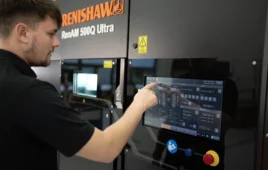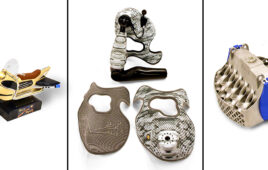Aerospace company teams with additive manufacturing to further construction on airplane turned hospital seeking to heal blindness around the world.
Orbis is an airborne ophthalmic training facility called a Flying Eye Hospital. By making it possible to bring ophthalmic training to communities around the world, the company’s goal is to eliminate unnecessary blindness. According to Orbis, “…of the 39 million blind around the globe, 80%, or almost 32 million, suffer needlessly.”
To heal blindness, the Orbis team not only performs eye surgeries, but also educates other doctors in the proper execution of eye surgeries through two-way audio-visual links. To be everywhere to aid and instruct as many people as they can, Orbis’ entire hospital and training facility is housed on a converted DC-10 aircraft. Orbis is now in the process of building a new airborne hospital.
A DC-10 aircraft has been converted to a flying eye hospital where staff perform surgeries and educate other doctors on latest eye health care.
The engineering team involved in the latest Flying Eye Hospital project first sought out over seven companies that could help build the new facility. They came across Structural Integrity Engineering (SIE), a company that re-designs, re-builds, and re-claims old and unused aircraft. One of the more complex components needed for the project was an air duct that was required to conform to certain curvatures, as well as meet all FAA requirements for airflow. Its purpose is to filter air between the cockpit and the operating rooms.
The Orbis team chose to use a 3D Printing process to produce the air duct. Mark Curran, Senior Engineer at SIE, has been working with additive manufacturing processes for years, but always as a way to prototype and test out new parts using Stereolithography (SLA). During design and form and fit testing, Curran and his team realized that traditional methods of manufacturing ducts would not suit the geometry of the air duct needed on the Orbis plane.
“We had done work with Solid Concepts in the past because 3D printing processes are very viable for complex fitting and design, which would normally cost quite a bit if machined,” stated Curran. “In discussing our needs with Jesse (a Solid Concepts Project Engineer), he informed me that Solid Concepts has material that is FAA compliant for smoke and burn regulations. We received samples of ULTEM and did secondary burn tests. To pass, the samples have to extinguish by themselves within a certain amount of time. The ULTEM pieces passed the test.” ULTEM is a thermoplastic material that has been engineered to meet harsh environments, which is why the material has become widely used in the production of large vehicles, such as automotives, industrial equipment, and aircraft.
Ultem builds in 0.010 in. and 0.013 in. layer thicknesses. The part stands at two feet long and one and a half feet in diameter.
The air duct, showing the build supports right after 3D printing
“We took what we normally would’ve done in fiberglass and shifted our approach,” continued Curran. Instead of fiberglass, Curran and his team chose to use a Fused Deposition Modeling (FDM) process coupled with the tan ULTEM material. “We designed mounting feature attachment fittings into the actual part. The mounting features are usually separate. By designing them into the FDM ULTEM component, we reduced our overall part count, which is always a good thing.”
FDM is an additive manufacturing process. It works similar to a hot glue gun, extruding thermoplastics varying in degrees of durability, layer by layer, until a final product is achieved. The process, as Curran explained, allows for multiple features to be built into the actual completed product, opening up possibilities for designers to program virtually any feature they require. Had Curran and his team manufactured the duct using fiberglass, the machined mold and lay-up process would have taken weeks; with FDM, the team was able to receive their part in a matter of days, and should they need a replacement or an extra part, the team could receive multiple parts in just a few days.
Building a part that would be required to function on an actual aircraft (versus a prototype or non-critical part) required vigorous inspection by the FAA. The FAA sent two representatives to Solid Concepts to test and certify the design and build of the air duct. First, a Designated Engineering Representative (DER), who is commissioned by the FAA and carries a legal license for engineering, visited Solid Concepts to verify that the design of the duct would meet airworthiness requirements. A Designated Airworthiness Representative (DAR) who inspects the part to ensure everything was built correctly and that the process used meets all airworthiness requirements, visited once the duct had been built. Solid Concepts took on the responsibility for ensuring the additive manufactured duct was 8130 certified.
“Being responsible for FAA certifications opened our eyes to what additive manufacturing can accomplish,” stated Solid Concepts’ Project Engineer Jesse Marin. “We’ve always been dedicated to internal research, and improving manufacturing processes, and I think it really paid off in this project.”
The Orbis team has never before used a 3D Printed unit on one of their Flying Eye Hospitals. The completed duct is 30 in. x 12.08 in. by 17.65 in. with a volume of 139.21.
The completed duct in place in the DC-10 aircraft
An earlier prototype of the air duct has been awarded a place in the National Additive Manufacturing Innovation Institute (NAMII) in Washington, D.C., to display the capabilities of 3D Printing and transfer those visionary and realistic ideas to the mainstream U.S. manufacturing sector.
Jack Mc Hal, MD 10 Program Director of Orbis International, commented that their objective “is to build the most sophisticated, technologically advanced, state of the art, gold standard hospital platform:” additive manufacturing was able to meet those standards.
Structural Integrity Engineering (SIE)
www.sieinc.com
Solid Concepts
www.solidconcepts.com
ORBIS International
www.orbis.org
Filed Under: 3D printing • additive • stereolithography, Make Parts Fast




